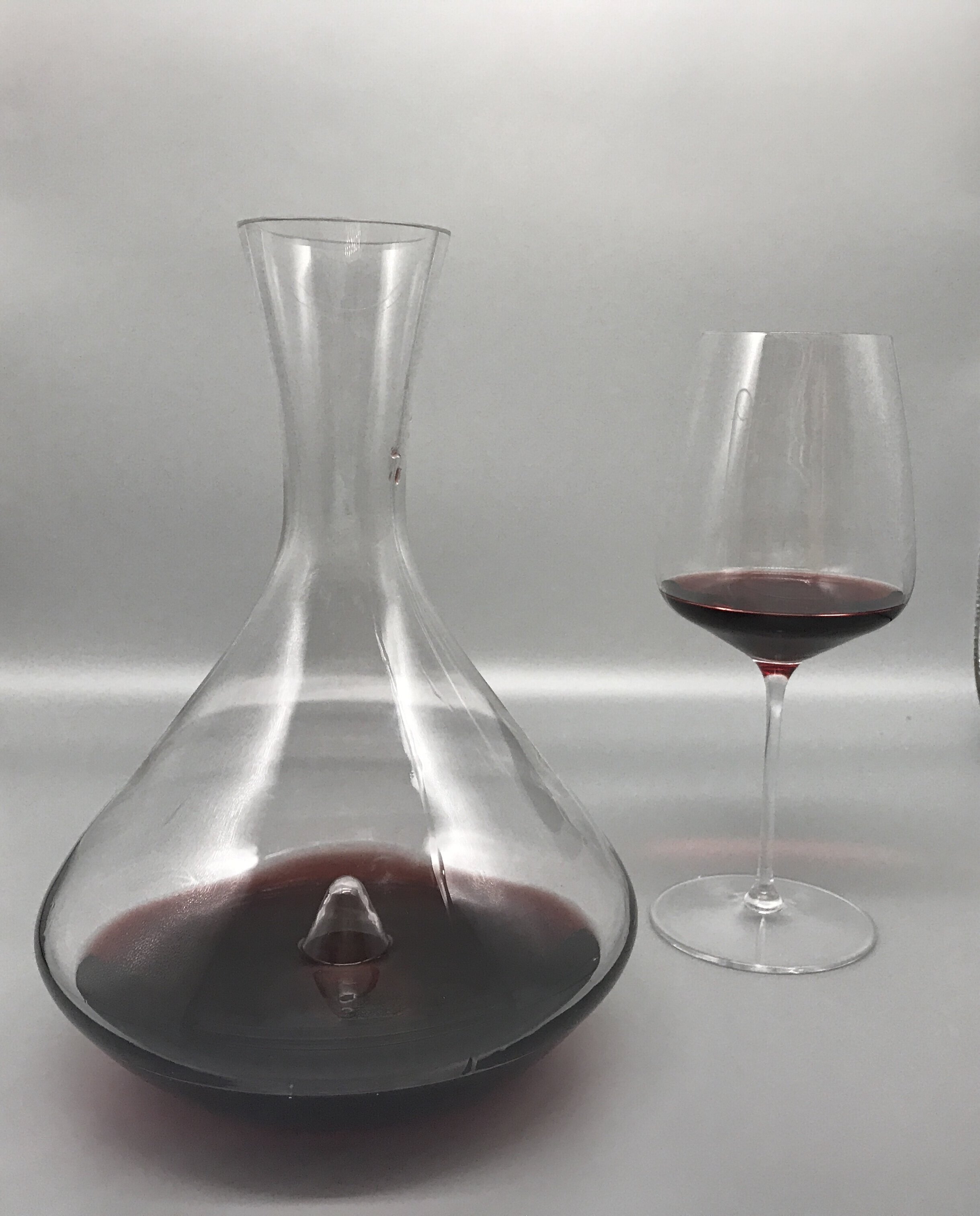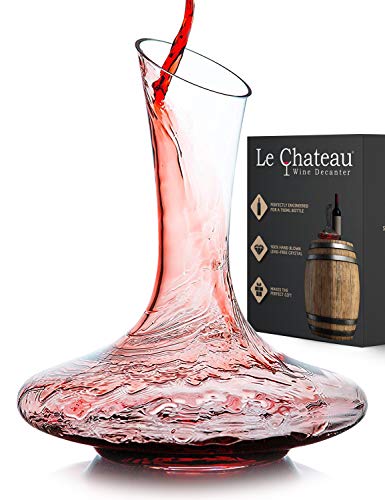If you are looking to purchase a decanter or are simply curious about how decanters work, you’ve come to the right place. Decanting might look elegant and intimidating, but there’s no secret to the art of decanting. In fact, if you’ve spent any time in a kitchen or laboratory, you probably already know a lot more about decanters than you realize! In this blog, we’ll demystify the art of decanting as well as recommend a few of our favorite decanters.
Before we continue with our review, though, a little about the KnowWines blog. We are an Amazon.com affiliate and we do receive a small commission if you purchase items through our affiliate links at no cost to you. The commissions we receive help us pay for web hosting fees, products to test, and other costs associated with running this site. Thanks for using our affiliate links and supporting our independent blog!
What is a wine decanter?
According to The Oxford Companion to Wine by Jancis Robinson, a decanter is typically a handleless clear glass bottle or container exceeding one-liter holding capacity. The decanter may or may not have a closure.
Wine decanters have been around at least since Roman times. Historically, they have been comprised of various materials including earthenware, glass, crystal, bronze, silver, or gold.
Do you need a wine decanter?
No, you don’t need a wine decanter, though there are certainly benefits and pleasures to using one.
If you don’t purchase much wine to drink at home during the year, you can find another suitable one-liter or larger container to aerate wine before consuming. Suitable substitutes include a glass pitcher, a blender carafe, or even a salad bowl. You simply need a container large enough to hold the volume of wine you wish to decant. The larger the surface area, the faster the poured wine will “breathe”.
If you are enjoying one glass of young wine for yourself, you don’t need to hassle with a decanter. Simply place the wine in a glass with a broad bowl like this one and swirl the wine in the glass. Then, let it sit for a few minutes.
If you simply love the shape and allure of decanters or drink wines often enough that you desire to own a decanter, then, by all means, purchasing and using a decanter will increase the pleasure of consuming wines. As decanters can get rather large, decorative decanters have become popular (a large decanter typically can’t fit in a standard cupboard or shelf, and so must be displayed on a countertop or open shelf).
What does a wine decanter do?
At the end of the day, a decanter is simply a receptacle for holding wine.
When decanting younger wines, a decanter simply serves as a vessel for carefully exposing young wine to oxygen before it is consumed. Exposing wine to oxygen allows the young wine to breathe and open up. Decanters intended for younger wines tend to have a wide base. Using a decanter to aerate a young wine is more effective than simply opening a bottle of wine and sitting it on a countertop for an hour or so. Leaving the wine in the bottle with the cork removed only exposes the wine in the neck of the bottle (a very small portio) to oxygen.
When decanting older wines (typically wines with some sediment in the bottom), the decanter serves as a place to separate the wine from the sediment that will remain in the original wine bottle. Decanters (or carafes) for older wines tend to be narrower at the base.
Why use a wine decanter?
Wine decanters are used for three main reasons, which we have detailed below.
Decanting Still Wines to Aerate Them
Many still (non-sparkling) wines benefit from controlled exposure to oxygen before consuming them. This process allows the wine to open up and breathe before serving.
Decanting young wines is not always necessary, as many modern wines are made for immediate consumption. However, if you are consuming a fine wine, artisanal wine, or quality wine from an independent producer, the wine will likely require some decanting as it has likely not been filtered as much as simpler commercial wines.
Decanting Wines with Sediment
Prior to the implementation of filtration systems in many wineries in the 20th century, many wines would build up sediment as the wine aged in the bottle. So that the sediment didn’t end up on your or your guest’s glass, wines were (and are) poured from their original bottle into a decanter over candlelight. Once the sludge of sediment is visible in the neck of the bottle, the pourer puts down the wine bottle and places the decanter on the table. Then, guests enjoy the wine as it is poured from the decanter into individual wine glasses.
Decanting Cheap Wines to Disguise Frugality
If you are hosting a wine party on a budget for a crowd or want to switch over to some cheap wine later in the evening, pouring cheap wine from a box or inexpensive bottle into a nice decanter will “dress up” the wine presentation. Brilliant!
How do I use a wine decanter?
It’s really quite simple, no need to overthink it! We’ve found the best way to learn how to decant is by watching someone else with training and experience wines. To learn more, check out this video on the decanting of young wines in a large decanter and older wines (via candlelight) into a narrow-based decanter (carafe).
Decanting an Older Wine
If you are decanting an older wine, you really don’t want to decant it until just before consuming, as some of the aromas will become muted and disappear with exposure to oxygen. With an especially old wine, you will want to cover the top of the decanter (carafe) with some sort of enclosure so that aromas don’t escape.
Decanting Younger Wines
If you are decanting a younger wine, such as a premium or artisanal wine from a region like Bordeaux, the Rhone, or Napa, you will need to do a little experimentation and let the taste be your guide. First, pour yourself a small taste before decanting. If the aromas and flavor are quite muted (not very expressive), then you might need to decant the wine for an hour or more. Our best advice is to keep tasting a sip or two at a time, 15-20 minutes apart, until it starts to taste as you like (such hard work!). To anticipate how long this might be, you can consider looking up others’ tasting notes on an application like Cellar Tracker to see how long the same wine was decanted by other people who drank it. You may need to take this information with a grain of salt as everyone has different preferences for length of decanting, but at least you’ll get a general idea of the decanting period (which could be anywhere from 30 minutes to 3 hours!).
If you are decanting a very young wine, such as a cheap wine from the grocery store, decanting for 15 to 30 minutes is usually sufficient.
What are the different types of decanters?
Decanters vary by construction, shape, design, and price. The material of which the decanter is made and the shape are significant factors.
Materials Used to Make Decanters
Basically, you want a decanter that is made of an inert substance that will not interact with the wine you wish to decant. This means plastic is typically out of the running. Commercially available decanters are typically made from glass, crystal, earthenware, and silver.
Glass decanters are typically the least expensive and least durable. However, they generally take to automatic dishwashers better than crystal decanters, mostly due to their thick walls.
Crystal decanters are quite durable. Crystal decanters can be mouth-blown or made from a mold. Crystal decanters are also likely to be more elaborate in shape than glass decanters, as even very thin walls can be quite strong.
Different Shapes of Decanters
As trends come and go, so do the shapes of decanters.
We categorize decanters into two main groups: tall thin carafes for decanting older wines and broad-bottomed decanters for younger wines.
You will find various sources describing the differences between decanters and how they affect wine. However, we’ve found that there’s really a very minimal difference in the aroma and flavor of wine decanted in the various types of decanters outside of these two groupings of tall/thin and broad/round.
When you are shopping on the internet or at a bottle shop, antique shop, or large retail shop like Williams Sonoma or Crate & Barrel, you will find lots of cool names for decanter shapes, like shaft and globe, Indian club, taper, shoulder, mallet, pillar cut, cruciform, cornett, and duck (to name a few!).
How do I clean a wine decanter?
If you clean your decanter right after using it,, you can usually just triple rinse the decanter with hot water from the tap. If wine sat in the decanter for a few hours or overnight, however, a more aggressive approach to cleaning will be needed.
After a night of drinking, cleaning a decanter can be quite a bother. If you don’t have time or are afraid that you will damage a decanter in a tired (or inebriated) situation, we recommend a quick rinse followed by filling the decanter with an inch or so of water so that you don’t have to fight with a stain in the morning.
Most glass decanters (and some crystal decanters) can be washed in the dishwasher. If in question, we recommend washing by hand. When washing by hand, try to minimize aromas and residues on both decanters and any fine glassware by washing the glassware in warm water using fragrance-free dish soap. We use this brand:
When washing by hand use a decanter brush to get into the nooks and crevices of a decanter. We like this one:
How do I remove wine stains from a wine decanter?
If a wine stain is not removed by the above methods, there are still a couple of approaches to cleaning dried-on wine stains deep inside the decanter.
Decanter Beads
There are beads designed specifically for the purpose of removing stubborn wine stains in the decanter. Carefully place beads in the decanter with soap and water, then swirl to free the debris. Invert the decanter and collect the beads in a kitchen sieve. When you’re done, rinse, dry, and store your decanter beads in the container the beads came in.
Denture or Retainer Cleanser
If you entertain frequently or are often battling dried on lipstick or wine stains in glassware, do what the pros do - use denture cleaner! Place a tablet in the decanter, fill with a couple inches of water, and let the decanter sit overnight. This often removes the most stubborn wine stains. When cleaning individual pieces of stemware, we break up a denture tablet and insert just a piece of the tablet into each piece of glassware that requires some deep cleaning. Fill the glass to just above the stain.
Hard Water Stains
Perhaps your roommate or well-intentioned spouse used your favorite decanter for a flower vase or to temporarily house a goldfish when an aquarium started leaking. Or maybe you live in an area with especially hard water and are annoyed by that invisible film that keeps showing up on your glassware.
Here’s a product that’s used in the craft beer industry to clean glassware with hard water mineral stains from calcium and other naturally occurring elements and minerals.
How do I polish and dry a wine decanter?
To prevent water spots on the outside of the decanter, we recommend a quick once-over with a fun glassware polishing cloth like this one. You can also use this glass polishing cloth for cleaning glassware, eyeglasses, and photography lenses!
To air out the inside of the decanter, you have a couple options. First is to “wedge” the decanter into a dish drying rack. This is a good option if you have an inexpensive glass decanter.
If you have an artistic or treasured wine decanter, consider getting a decanter drying rack like this one. We like this drying stand as it has rubber coating to prevent scratches to the decanter.
Which decanter should I purchase?
Now that you know everything there is to know about decanters, we’ll share our three favorite wine decanters.
Best Wine Decanter for Older Wines
This mouth-blown lead-free decanter from Austria can be used to decant one 750 mL bottle of wine. It’s a good decanter for older wines as one can minimize exposure to oxygen. This very high quality of crystal has no distracting design, allowing one to easily see the color of the aged wine.
In addition to decanting wine, this carafe can be used to serve water, juice, or other beverages. The hourglass shape is attractive and easy to clean. This decanter is also dishwasher safe. 2500 mL versio is also available if you need to decant a magnum (1.5 L) bottle of wine.
Best Inexpensive Glass Wine Decanter
If you are looking for a simple, dual purpose wine decanter (for new and old wines) that is inexpensive, this decanter may be for you. In addition to being economical, it does not have a wide base, making it easy to store. This decanter also has an insert that can be used for aerating younger wines (use without the insert for older wines). Due to its shape, this decanter does not scream “wine decanter,” so it can be used for beverages other than wine, like orange juice or flavored water.
Best Multi-Purpose Lead-Free Crystal Wine Decanter
Perhaps you already have a glass decanter and want your second decanter to be a lead-free crystal wine decanter. This one has a very wide base (8.5 inches) and plenty of surface area for decanting. The slanted top makes it attractive and easy to pour.
Best “Splurge” Lead-Free Crystal Wine Decanter
This mouth-blown, high quality, lead-free decanter made in Austria has a sleek design that maximizes surface area of the wine to oxygen. The decanter easily holds a 750 mL bottle of wine and is easy to pour and clean.
Wine Decanter Wrap-Up
We hope you learned something about wine decanting and that you feel less intimidated by the process. Have more questions or a favorite wine decanter you want to tell us about? Share in the comment section! Happy decanting!
Cheers from KnowWines!













